 BSTRACT:
The fry pattern of aquarium-bred species of the South-American
catfish genus Corydoras, contribute to discriminate
between species of the so-called 'acutus'- group, showing
a greyish adult colour pattern. BSTRACT:
The fry pattern of aquarium-bred species of the South-American
catfish genus Corydoras, contribute to discriminate
between species of the so-called 'acutus'- group, showing
a greyish adult colour pattern.
INTRODUCTION:
Identifying many of the Corydoras species can
be extremely difficult and none more so than the long-snouted
members in, the sosh adult colour patterns. Although
there are about twenty species within this group, seven
species were successfully bred under controlled aquarium
conditions. It is demonstrated that the colour patterns
change during the fry's three to four month period to
adulthood and maturity. It was thought that juvenile
colour patterns might be an additional character with
which to differentiate between the different species.
This was demonstrated earlier with two of the short-snouted
species of Corydoras: C. rabauti (La Monte,
1941) and C. zygatus (Eigenmann & Allen,
1942). They were considered as one species by many authors,
until breeding experiments by the author (Fuller, 1983a)
revealed that these two species possessed totally different
body colour patterns during their larval stages.
MATERIAL:
The seven species involved are: C. acutus (Cope,
1872): 4 males-2 females, C. blochi blochi (Nijssen,
1971): 2 males-4 females, C. septentrionalis (Gosline,
1940): 3 males-2 females, C. treitlii (Steindachner,
1906): 2 males-2 females, C. amapaensis (Nijssen,
1972): 3 males-i female, C. ellisae (Gosline,
1940): 3 males-3 females, and C. stenocephalus
(Eigenmann & Allen, 1942): 2 males-2 females, all
obtained from aquarium fish importers. The fry colour
patterns are recorded in line drawing form, and were
made when the fry had reached the age seven days and
twenty-eight days respectively, and at the time when
they reached the pattern of an adult female. The adult
female pattern was chosen as the datum point at which
fry are deemed to have reached their adult coloration.
(Figs. 1-7).
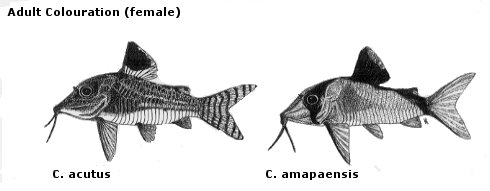
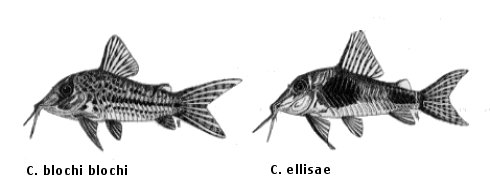
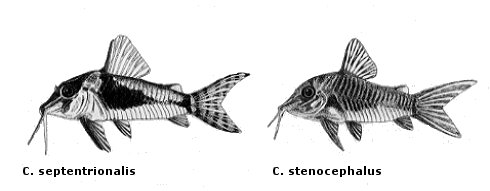
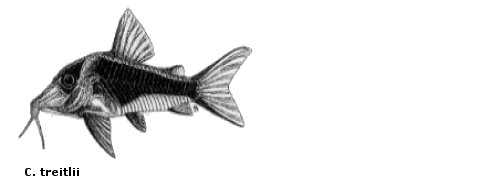
Figs.
1 - 7. Adult females of seven long-snouted species of
Corydoras: C. acutus, C. blochi blochi, C.
septentrionalis, C. treitlii, C. amapaensis, C. ellisae,
C. stenocephalus.
Table
I.
Water conditions of the tanks
during the time of spawning of seven Corydoras
species.
pH (Pondus hydrogenii) = acidity! alkalinity; neutral
measurement = 7.
GH (General hardness = total hardness, measured in degrees
dH) is a measure of all dissolved salts. 0-5 = soft,
6–10 = medium, 11-20 = medium hard = medium hard.
KR (Carbonate hardness) a measure of (bi)carbonates.
Temperature recorded in degrees Celsius
|
pH |
GH (dH) |
KH |
Temp |
Corydoras
acutus |
7.2 |
12 |
2 |
21,1 |
Corydoras
amapaensis |
7.4 |
14 |
1 |
23,3 |
Corydoras
blochi blochi |
6.8 |
10 |
3 |
25,5 |
| Corydoras
ellisae |
7.0 |
9 |
1 |
23,3 |
Corydoras
septentrionalis |
7.4 |
8 |
1 |
23,8 |
Corydoras
stenocephalus |
6.8 |
10 |
3 |
25,5 |
Corydoras
treitlii |
7.4 |
12 |
2 |
22,2 |
METHODS:
All seven species were bred in aquariums of similar
size (length 45cm, width 35cm, height 30cm), with similar
furnishings. All seven species spawned in a very similar
way following a pre-determined sequence of events.The
sexual activity starts with a male of the species actively
pursuing one of the females until she submits to his
attentions, at which point she reverses rolls and pursues
the male. The male then takes on a quivering arched
sideways stance, allowing the female to push headfirst
into the side of his body, at a point just above and
slightly in front of the ventral fins. At the moment
of contact the male grips the female by clamping across
her barbels with his pectoral fin spine, holding her
firmly against the side of his body. The grip is maintained
until the male has stopped quivering, this grip being
referred to as the 'mating clinch'. Both fish then separate
with the female actively cleaning various sites around
the aquarium before depositing her eggs, the male being
in close attendance all the time and ready to mate.
During the mating clinch which may take place at all
levels in the aquarium from the substrate, in amongst
the plants and spawning mops to mid water, the female
will deposit her eggs into a pouch made by pressing
her ventral fins together. When a pair of fish mate
in mid water and after the male has stopped quivering,
they drift to the substrate where they may rest for
several seconds before separating. No method has yet
been devised to successfully determine how and at what
point the eggs are fertilised.
In each
of the seven species spawning activities the none participating
fish were left in the aquariums with the spawning pairs
and in all seven cases the none participating females
showed no interest at all. The males however persisted
with their attempts to mate with the active female,
in all seven cases the first male selected by the female
made sure that he was always between her and the other
pursuing males. With all seven species after spawning
activity had ceased the adult fish were removed.
CONDITIONS:
None of the seven species (Table I) showed preference
as to the level at which to deposit their eggs,
with eggs being deposited close to the substrate
and to within twenty millimetres of the surface.
The fry of all seven species take from between eighty-five
to one hundred hours to hatch (Table II) depending
on the water temperature. Although the temperature
is not a controlling factor it does have a slight
bearing on the developing embryos. For example,
C. acutus that spawned at 21,1 deg C. and
took between ninety and one hundred hours for all
of the fry to emerge. When spawned at 23,9 deg C.
they would hatch in eighty-five to ninety five hours,
but at 26,5 deg C. they still take between eighty-five
and ninety five hours to hatch. Of the seven species
(Table II) bred five, C. acutus, C. ellisae,
C. septentrionalis, C. stenocephalus,
and C. treitiii, preferred to deposit their
eggs in either Java Moss or the woollen spawning
mops. The remaining two, C. amapaensis, and
C. blochi blochi divided their eggs evenly
between the tank sides and the clumps of Java Moss.
The growth rates shown inTable
Ill are an average taken from ten specimens to the
nearest 0.5 mm.
Table
II.
Details of egg production of seven Corydoras
species. Per column: total number of eggs, diameter,
number of eggs laid at a time, adhesion, and time
to hatch. The adhesion (how well they stick) is
a value of personal rating out of 10.
|
|
|
|
|
| C.
acutus |
|
|
|
|
C.
amapaensis |
|
|
|
|
C.
blochi blochi |
|
|
|
|
C.
elisae |
|
|
|
|
C.
septentrionalis |
|
|
|
|
C.
stenocephalus |
|
|
|
|
C.
treitlii |
|
|
|
|
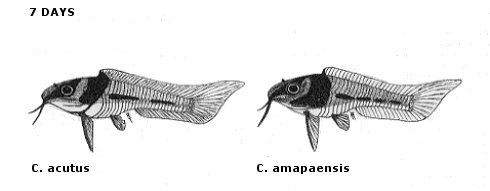
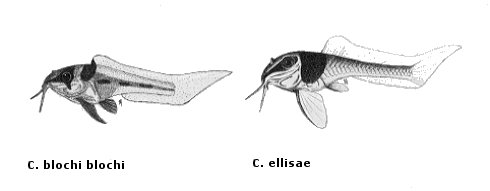
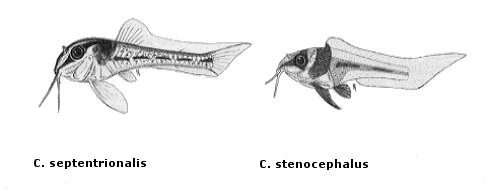
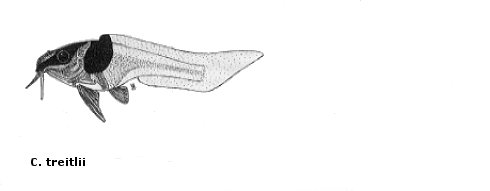
Figs. 8 - 14.
Aged 7 days; seven long - snouted species of Corydoras:C.
acutus, C. blochi blochi, C. septentrionalis, C.
treitlii, C. amapaensis, C. ellisae, C. stenocephalus.
Table
111.
Fry growth rates of seven Corydoras species,
showing their total lengths per period of time.
|
|
|
|
|
|
Corydoras
acutus |
|
|
|
|
|
Corydoras
amapaensis |
|
|
|
|
|
Corydoras
blochi blochi |
|
|
|
|
|
Corydoras
ellisae |
|
|
|
|
|
Corydoras
septentrionalis |
|
|
|
|
|
Corydoras
stenocephalus |
|
|
|
|
|
Corydoras
treitlii |
|
|
|
|
|
By the seventh day after
hatching the fry of all the seven species have developed
their own distinctive colour patterns. (Figs. 8-14).
Five of the species (C. acutus, C. amapaensis,
C. blochi blochi C. septentrionalis and C. stenocephalus)
show patterns that are rather similar to each other.
C. ellisae and C. treitili have exactly
the same patterns as each other, differing from
the other live species by having no markings along
the sides of the body.
As the fry of the seven
species grow and develop, their colour patterns
are constantly changing and reach a maximum intensity
by the time they are four to six weeks old. The
pigmentation forms into irregular markings that
cover most of the fishes body, giving all seven
species a dark blotchy appearance especially when
viewed from above, as shown in Figs. 15-21. From
six weeks onward the ever changing colour patterns
of the fry, start to develop into the more recognisable
patterns of the adult female.
By the time the fry of all
seven species are aged between eight and ten weeks
old, they will all have attained the colour pattern
shown by adult females, as demonstrated in Figs.
1-7.
The effect of water temperature
on all the fry's growth rates, is very much the
same as on egg development. More importantly water
quality does have a positive effect on growth rates.
Water quality that had been allowed to deteriorate
through contamination from excess build up of the
fry's waste matter effectively retarded growth,
it is thought that permanent growth damage would
occur if conditions were allowed to prevail for
any length of time. To maintain maximum fry growth
rates daily 30% water changes were made.
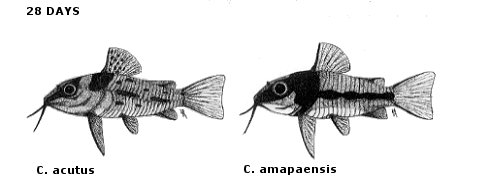
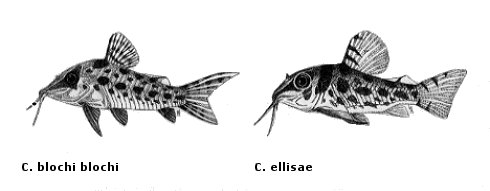
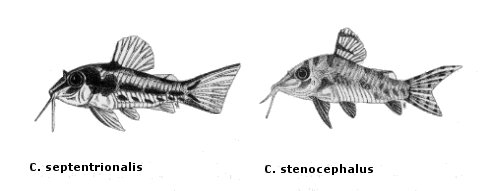
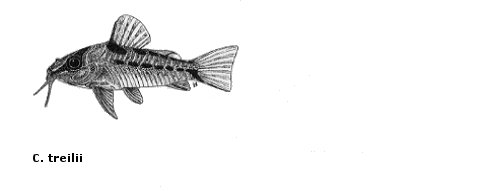
Figs. 15 - 21.
Aged one month: seven long - snouted species of
Corydoras:C. acutus, C. blochi blochi, C. septentrionalis,
C. treitlii, C. amapaensis, C. ellisae, C. stenocephalus.
DISCUSSION:
Adult female coloration was chosen as the time at
which fry were deemed to have reached adulthood.
This was because with other species of Corydoras
e.g. C. barbatus (Quoy & Gaimard,
1824) that have been bred - where there are known
colour differences between the sexes - the males
of some of these species can take a further eight
or even as long as twelve weeks to mature and develop
their adult colours. (Fuller, 1983b).
With the seven species so far bred from the 'acutus'
group there were no discerning colour differences
between the sexes that could be readily recognised.
The first visual signs of maturing males are in
the fin spines, the pectoral and ventral fins being
the most prominent; becoming thicker and more elongated.
In mature males of the seven species spawned the
ventral fins are possibly the most reliable indicator
of sex, as these become elongated and pointed compared
to the rounded tan shaped fins of the temales.
As with most
animals, growth rates can vary tremendously. Corydoras
fry are no exception, and caused some concern when
one or two of the faster growing quicker developing
males became dominant and were observed chasing
and bullying smaller less mature specimens. The
aggression became so intense preventing the smaller
fry from feeding altogether.
To further
assist and improve the survival rate of the smaller
male fry, large clumps of Java Moss were placed
in all the fry rearing tanks. This had the effect
of giving all the fry a secure refuge, and enabled
the smaller males to avoid the bullying by the larger
ones. It also had the effect of reducing the amount
of squabbling between males of equal size, enabling
the majority to reach adulthood (between sixty and
seventy percent of the fry of all seven species
reached adulthood).
Long-term observations
have shown that female Corydoras fry grow
at a faster rate than males, as twenty percent.
With the seven species bred from the 'acutus'
group there is a difference of between ten and fifteen
percent in standard length after ten months. Despite
growth variation within each of the sexes, after
ten to twelve week's males and females can be separated
with relative ease:
REFERENCES
Fuller, I.
1983a. Lookalikes unmasked. Practical Fishkeeping
January: 32-33.
Fuller, I. 1983b. Spawning Corydoras
barbatus. Freshwater and marine aquarium 6 (12):
24-25, 67-68.
Nijssen, H. & I.J.H. lsbrücker,
1980. A review of the genus Corydoras Lacepede,
1803 (Pisces, Siluriformes, Callichthyidae) Bijdr.
Dierk. 50(1): 190-220.
|













